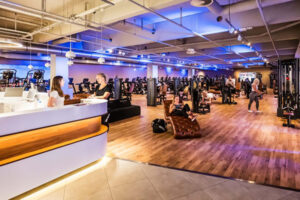TRANSFORMING SHOPPING CENTERS: PROACTIVE STRATEGIES FOR SUCCESS
● Experiential marketing is the future of retail: Consumers seek experiences beyond simple transactions, and shopping centers can use events and activities to attract visitors and strengthen community bonds.
● Data and tools are crucial for success: Empowering shopping centers to market events effectively, driving engagement, and fostering connections between retailers and shoppers.
● Revitalizing spaces fosters community: Hypothetical events like the Sensory Spring Fest illustrate how experiential marketing can breathe new life into shopping centers, creating a sense of community and inclusivity.
EXPERIENTIAL RETAIL: SHAPING THE FUTURE OF SHOPPING CENTERS
Consumers today crave experiences, not just transactional interactions, and this is especially the case with physical spaces. This trend is here to stay, and shopping centers should take measures to include this, if not emphasize it, in their marketing strategies. By leveraging data and advanced marketing platforms, shopping centers can be transformed into lively community hubs through experiential marketing.
SENSORY SPRING FEST: A HYPOTHETICAL EXPERIENTIAL EVENT
This multi-sensory happening is designed to engage visitors through sight, sound, taste, touch, and smell. Such a large and comprehensive event could feature:
● Interactive art installations: Large-scale art pieces that react to movement and sound, creating an immersive visual and auditory experience. Visitors can share their experiences on social media, generating an organic buzz.
● Culinary tasting stations: Partner with local restaurants and food trucks to offer a variety of samples, engaging the sense of taste. This could be coupled with cooking demonstrations by local chefs.
● Live music and performances: Featuring local musicians and entertainers, these performances add an auditory layer to the festival, attracting diverse crowds and creating a vibrant atmosphere.
● Tactile experiences: Craft stations where visitors can create art or jewelry, engaging the sense of touch. Workshops could include pottery, painting, or DIY crafts.
● Aromatherapy stations: Set up booths with different seasonal scents and essential oils, allowing visitors to relax and engage their sense of smell.
To maximize the impact of Sensory Spring Fest, tenants within the shopping center can align their offerings with the festival’s themes by hosting in-store events, offering special promotions, or showcasing products that engage the senses. For instance, a clothing store might host a fashion show featuring live music, while a tech store could offer interactive demonstrations of their latest gadgets. Collaboration between tenants can create a cohesive and immersive experience, drawing visitors to multiple stores and enhancing the overall atmosphere of the event.
ENHANCING EXPERIENTIAL MARKETING WITH TECHNOLOGY AND DATA
By leveraging data and advanced marketing platforms, shopping centers can be transformed into lively community hubs through experiential marketing. Technologies such as AI and machine learning can analyze shopper behavior and preferences, allowing centers to personalize marketing campaigns and event content. Geotargeting can ensure that promotional messages reach the right audience at the right time, driving attendance. Furthermore, real-time analytics can provide insights into visitor flow and engagement during the event, enabling organizers to make immediate adjustments to optimize the experience.
Post-event data analysis can reveal which activities were most successful, informing future strategies to enhance customer loyalty and repeat visits. This holistic approach ensures that every aspect of Sensory Spring Fest is designed to maximize visitor satisfaction and long-term engagement.
RETHINKING BRICK-AND-MORTAR RETAIL
As brick-and-mortar retail evolves, the definition of success must also change. Traditional metrics like sales per square meter should be challenged, or at least supplemented. Instead, we must consider the amount of experience offered per square meter. Such KPIs can be used to boost interest among potential tenants and increase tenant engagement. An added benefit is that tenants can see what their marketing contributions can realize.
Here are some of the benefits of such an experiential event:
● Measuring experiential value: Retail success should now be measured by the richness of experiences offered. Multi-sensory activities, interactive installations, and community events can turn shopping centers into destinations.
● Engaging all senses in shopping: Enhancing the customer experience through multi-sensory engagement is crucial. Examples include interactive light displays, immersive soundscapes, and aromatic environments. New technologies, such as AI, can personalize these experiences further, tailoring them to individual preferences.
● Integrating seamless advertising: Integrating advertising directly at the point of sale without disturbing the shopping experience is key.
EMPLOYING MEASURABLE STRATEGIES
To ensure the success of experiential marketing, it’s essential to employ measurable strategies. Data analysis methods like heat maps and customer frequency measurements can optimize store layouts and experience offerings.
Here’s how shopping centers can best leverage data:
● Heat maps: Using heat maps to track customer movement within the shopping center can reveal popular areas and potential bottlenecks. Some of this technology includes camera sensors, and Wi-Fi or Bluetooth tracking. This data helps design better store layouts and guides store management in placing experiential activities in high-traffic zones.
● Customer frequency measurements: Monitoring the frequency and duration of customer visits provides insights into shopper behavior and preferences. The use of promotional coupons and other incentives is also an easy way to measure impact. This information can guide the planning of events and promotions to maximize engagement.
● Real-time data utilization: Employing real-time data analytics during experiential events can help organizers make immediate adjustments to enhance the visitor experience. For instance, if a particular activity is attracting a large crowd, resources can be immediately reallocated to support it better.
THE FUTURE OF RETAIL IS EXPERIENTIAL
By embracing experiential marketing, shopping centers can create more engaging and memorable experiences, leading to increased traffic, sales, and loyalty. Smart shopping center marketers can use data-driven insights to tailor these experiences and keep shoppers coming back. While advanced platforms support the marketing and promotion of these events, it’s up to the shopping centers to craft these unforgettable experiences.
TECHNOLOGY AND MULTI-SENSORY EXPERIENCES
To further enhance multi-sensory experiences, shopping centers can leverage various technological advancements:
● Augmented Reality (AR): AR can transform the shopping experience by overlaying digital information onto the physical world. For example, an AR scavenger hunt can guide visitors through the shopping center, offering clues and rewards that appear on their smartphones.
● Virtual Reality (VR): VR experiences can transport shoppers to different environments without leaving the center. A VR installation could simulate a tropical vacation or a historical journey, providing an engaging and memorable experience.
● Artificial Intelligence (AI): AI-driven personalization can create tailor-made experiences for shoppers. Equally important, AI can analyze shopper data to suggest activities, stores, or products that match their interests, enhancing the overall experience.
INTEGRATING COMMUNITY AND RETAIL
Creating a sense of community within shopping centers is essential for fostering loyalty and repeat visits. Here are a few strategies:
● Community events: Hosting local events such as farmers’ markets, craft fairs, and holiday celebrations can draw in visitors and create a sense of belonging. These events can be supported by local businesses and artisans, reinforcing community ties.
● Educational workshops: Offering workshops on various topics, from cooking classes to tech tutorials, can provide valuable learning experiences and attract diverse audiences. These workshops can also highlight products and services available within the shopping center.
● Health and wellness initiatives: Partnering with local fitness instructors and wellness experts to offer yoga classes, meditation sessions, and health seminars can promote well-being and create a supportive community atmosphere.
SUSTAINABILITY AND ETHICAL PRACTICES
Consumers are increasingly concerned with sustainability and ethical practices. Shopping centers can address these concerns by:
● Eco-friendly design: Incorporating green building practices, such as using sustainable materials and energy-efficient systems, can reduce the environmental impact of shopping centers.
● Ethical sourcing: Promoting retailers that source their products ethically and support fair trade practices can appeal to socially conscious consumers.
● Recycling programs: Implementing comprehensive recycling programs and encouraging retailers to minimize packaging waste can make shopping centers more environmentally friendly.
The future of retail lies in creating immersive, multi-sensory experiences that engage shoppers and foster community connections. By rethinking traditional metrics of success and leveraging data-driven strategies, shopping centers can be transformed into vibrant hubs of activity. Integrating advanced technologies and focusing on sustainability and ethical practices will further enhance the shopping experience and help ensure long-term success.

Susan Hagerty Bonsak
Susan Hagerty Bonsak is CEO of Placewise.







